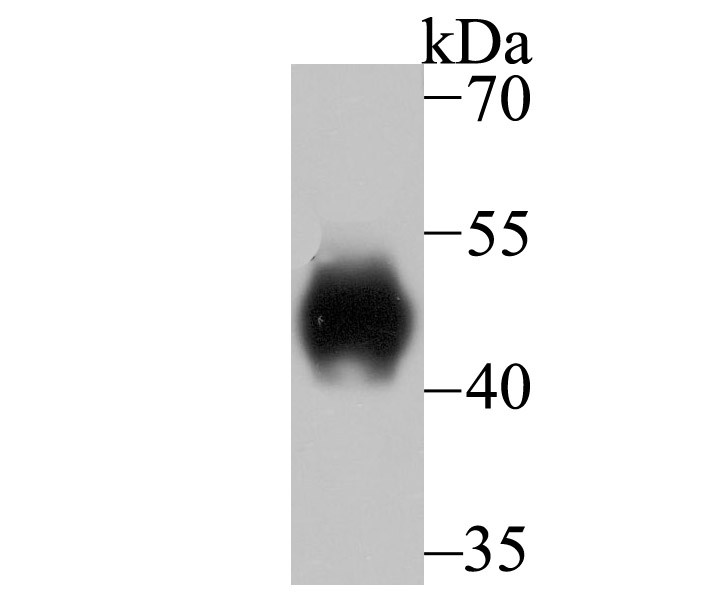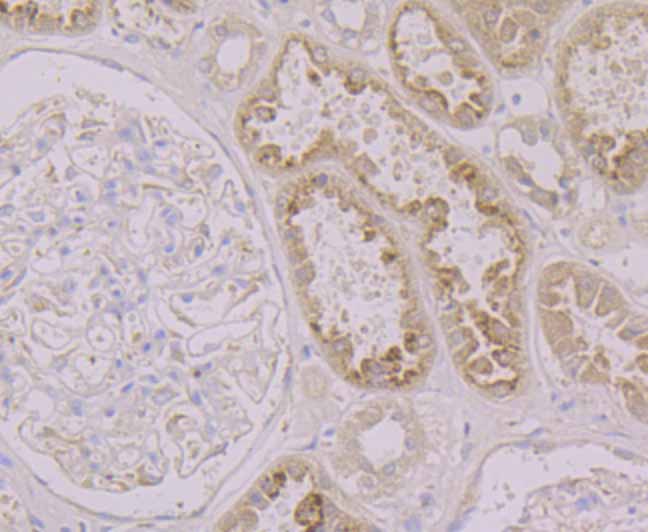Product Name :
LRG1 polyclonal antibody Background :
LRG1 (leucine-rich alpha-2-glycoprotein), also known as LRG, is a 347 amino acid secreted protein that contains eight LRR (leucine-rich repeats) and one LRRCT domain. The leucine-rich repeat (LRR) family of proteins, including LRG1, have been shown to be involved in protein-protein interaction, signal transduction, cell adhesion and development. Found mainly in plasma, LRG1 is expressed during granulocyte differentiation. The gene that encodes LRG1 consists of nearly 3,000 bases and maps to human chromosome 19p13.3. Chromosome 19 consists of over 63 million bases, houses approximately 1,400 genes and is recognized for having the greatest gene density of the human chromosomes. It is the genetic home for a number of immunoglobulin (Ig) superfamily members, including the killer cell and leukocyte Ig-like receptors, a number of ICAMs, the CEACAM and PSG families and Fc receptors (FcRs). Product :
Rabbit IgG, 1mg/ml in PBS with 0.02% sodium azide, 50% glycerol, pH7.2 Storage&Stability :
Store at +4°C after thawing. Aliquot store at -20°C or -80°C. Avoid repeated freeze / thaw cycles. Specificity :
LRG1 polyclonal antibody detects endogenous levels of LRG1 protein. Immunogen :
Recombinant protein Conjugate :
Unconjugated Modification :
Unmodification
LRG1 polyclonal antibody Background :
LRG1 (leucine-rich alpha-2-glycoprotein), also known as LRG, is a 347 amino acid secreted protein that contains eight LRR (leucine-rich repeats) and one LRRCT domain. The leucine-rich repeat (LRR) family of proteins, including LRG1, have been shown to be involved in protein-protein interaction, signal transduction, cell adhesion and development. Found mainly in plasma, LRG1 is expressed during granulocyte differentiation. The gene that encodes LRG1 consists of nearly 3,000 bases and maps to human chromosome 19p13.3. Chromosome 19 consists of over 63 million bases, houses approximately 1,400 genes and is recognized for having the greatest gene density of the human chromosomes. It is the genetic home for a number of immunoglobulin (Ig) superfamily members, including the killer cell and leukocyte Ig-like receptors, a number of ICAMs, the CEACAM and PSG families and Fc receptors (FcRs). Product :
Rabbit IgG, 1mg/ml in PBS with 0.02% sodium azide, 50% glycerol, pH7.2 Storage&Stability :
Store at +4°C after thawing. Aliquot store at -20°C or -80°C. Avoid repeated freeze / thaw cycles. Specificity :
LRG1 polyclonal antibody detects endogenous levels of LRG1 protein. Immunogen :
Recombinant protein Conjugate :
Unconjugated Modification :
Unmodification
-
 Western blot analysis of LRG1 on human serum using anti-LRG1 antibody at 1/500 dilution.
Western blot analysis of LRG1 on human serum using anti-LRG1 antibody at 1/500 dilution. -
 Immunohistochemical analysis of paraffin-embedded human kidney tissue using anti-LRG1 antibody. Counter stained with hematoxylin.
Immunohistochemical analysis of paraffin-embedded human kidney tissue using anti-LRG1 antibody. Counter stained with hematoxylin.
Bioworld Biotech only provide peptides for our antibodies and do not provide additional peptide customization services.
Price/Size :
USD 368/1mg/vial
Tips:
For phospho antibody, we provide phospho peptide(0.5mg) and non-phospho peptide(0.5mg).Describe :
Blocking peptides are peptides that bind specifically to the target antibody and block antibody binding. These peptide usually contains the epitope recognized by the antibody. Antibodies bound to the blocking peptide no longer bind to the epitope on the target protein. This mechanism is useful when non-specific binding is an issue, for example, in Western blotting (WB) and Immunohistochemistry (IHC). By comparing the staining from the blocked antibody versus the antibody alone, one can see which staining is specific; Specific binding will be absent from the western blot or IHC performed with the neutralized antibody.Formula:
Synthetic peptide was lyophilized with 100% acetonitrile and is supplied as a powder. Reconstitute with 0.1 ml DI water for a final concentration of 10 mg/ml.The purity is >90%,tested by HPLC and MS.
Storage:
The freeze-dried powder is more stable. For short time at 2-8°C. For long term storage store at -20°C.
Note :
This product is for research use only (RUO only). Not for use in diagnostic or therapeutic procedures.
 LRG1 polyclonal antibody
LRG1 polyclonal antibody  Datasheet
Datasheet COA
COA MSDS
MSDS SHIP
SHIP